AMN465: Analytical Report on Public Relations in Healthcare Sector
VerifiedAdded on 2022/10/17
|10
|2165
|5
Report
AI Summary
This analytical report examines the public relations strategies employed by the North Sydney Council in response to a smoking ban within the CBD. The report analyzes the tactics used, the target audience, and the rationale behind the communication strategy. It applies Grunig and Hunt's four historical models of public relations, specifically the two-way asymmetrical model, to evaluate the council's approach. The report also considers the role of public opinion in shaping policy and influencing stakeholder engagement. The mayor's approach involved council approval, public awareness campaigns, and the importance of stakeholder support. The analysis concludes that the council's approach, emphasizing a two-way communication strategy to address public concerns and garner support, was effective. The report also references the application of public opinion to influence policy making and implementation.
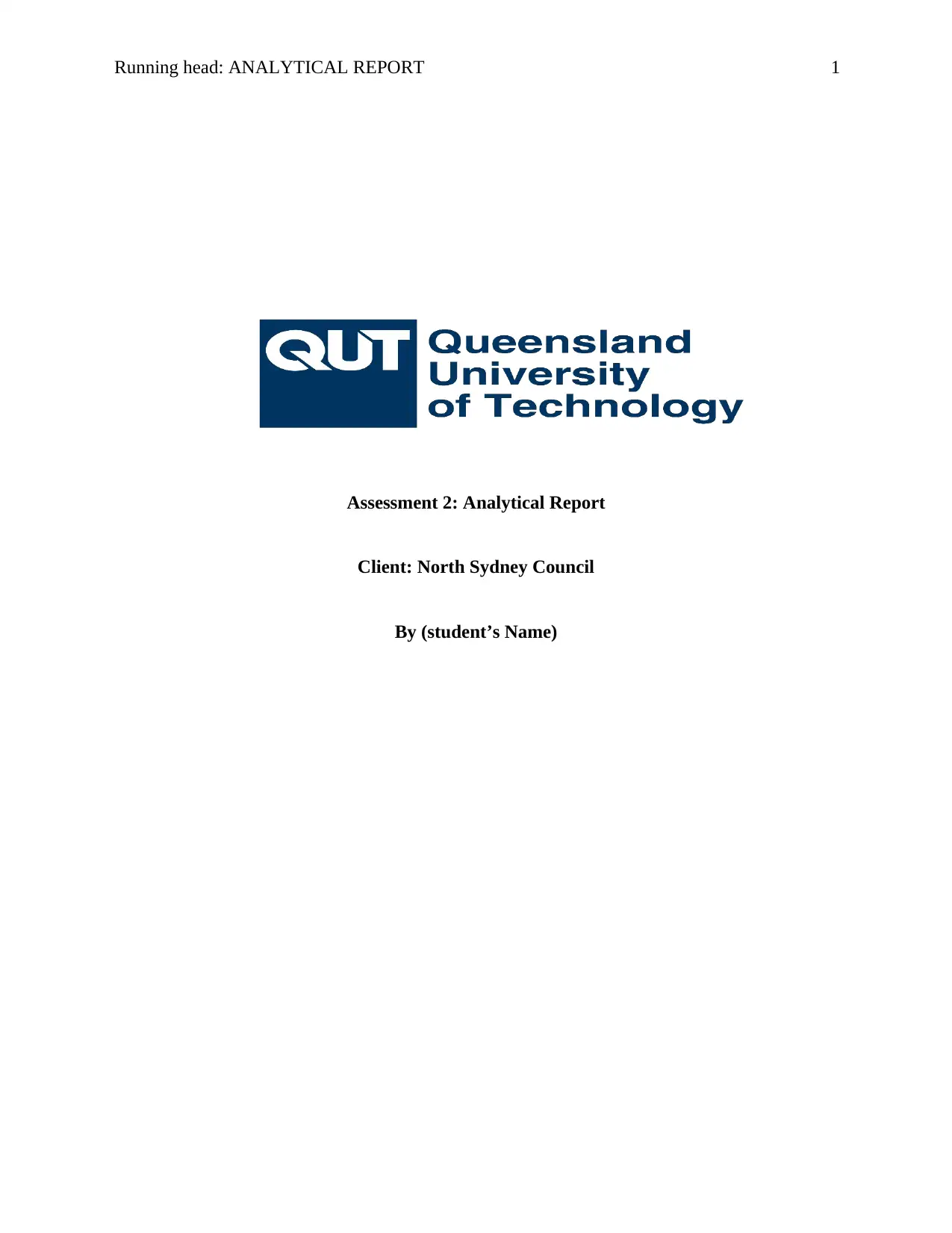
Running head: ANALYTICAL REPORT 1
Assessment 2: Analytical Report
Client: North Sydney Council
By (student’s Name)
Assessment 2: Analytical Report
Client: North Sydney Council
By (student’s Name)
Paraphrase This Document
Need a fresh take? Get an instant paraphrase of this document with our AI Paraphraser
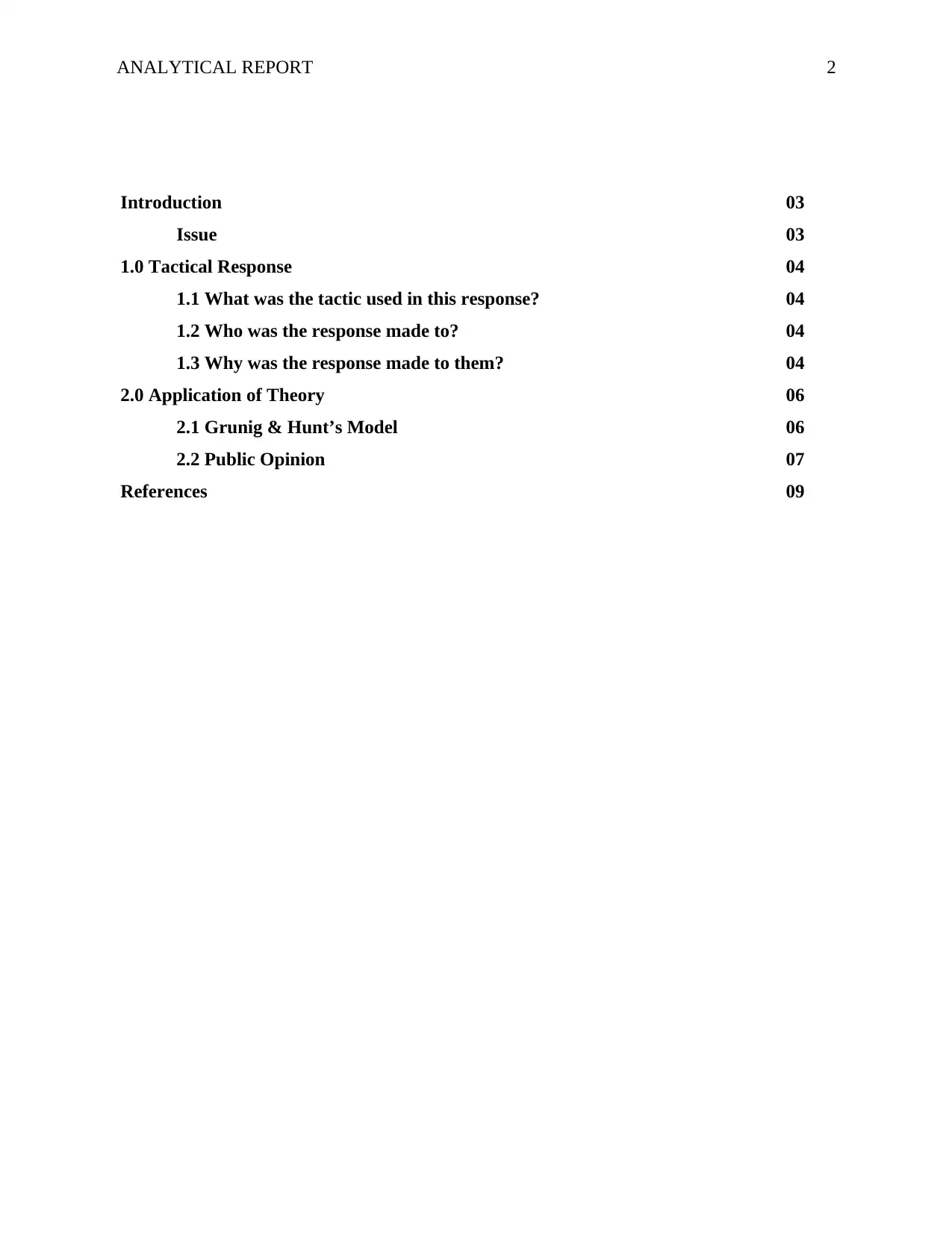
ANALYTICAL REPORT 2
Introduction 03
Issue 03
1.0 Tactical Response 04
1.1 What was the tactic used in this response? 04
1.2 Who was the response made to? 04
1.3 Why was the response made to them? 04
2.0 Application of Theory 06
2.1 Grunig & Hunt’s Model 06
2.2 Public Opinion 07
References 09
Introduction 03
Issue 03
1.0 Tactical Response 04
1.1 What was the tactic used in this response? 04
1.2 Who was the response made to? 04
1.3 Why was the response made to them? 04
2.0 Application of Theory 06
2.1 Grunig & Hunt’s Model 06
2.2 Public Opinion 07
References 09
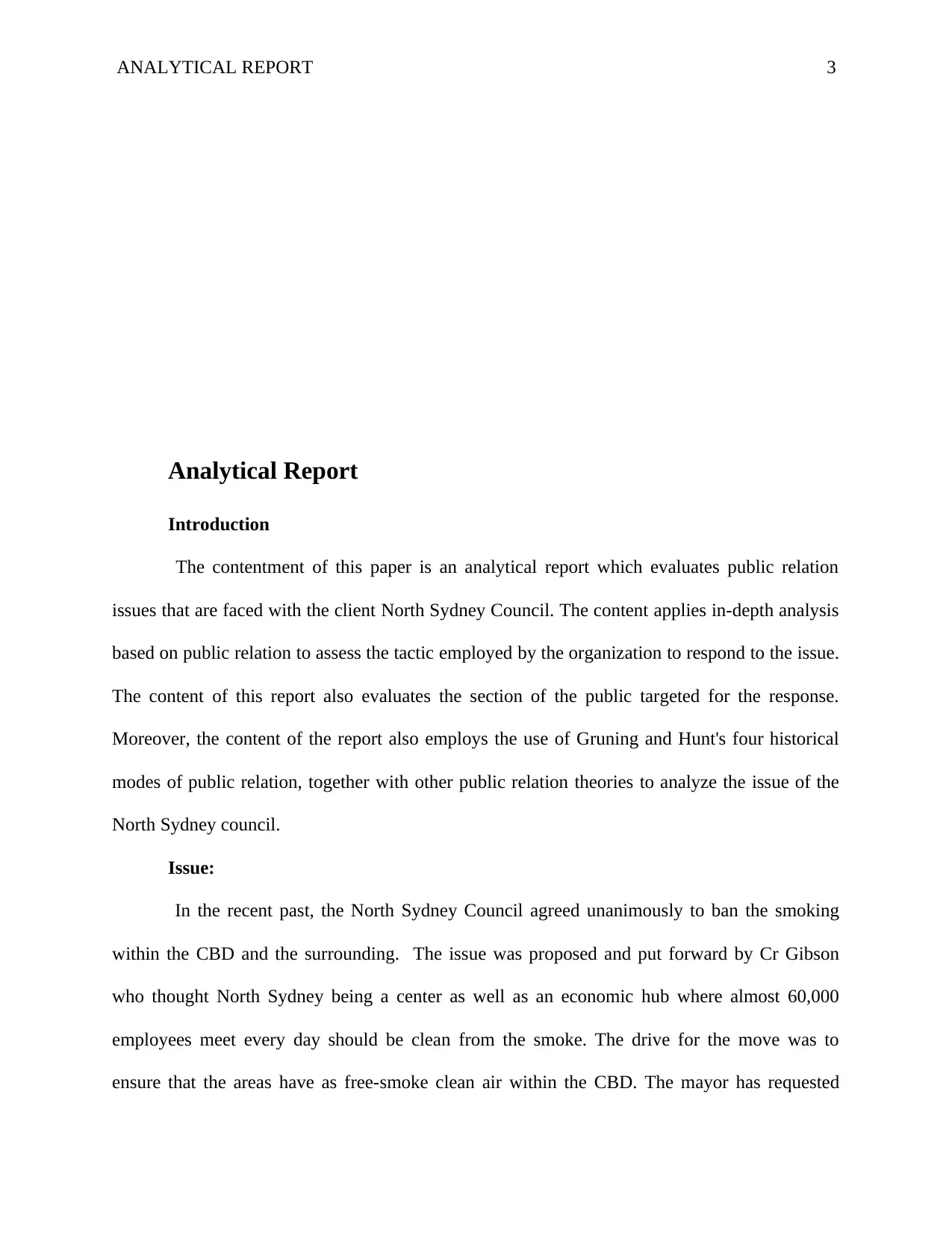
ANALYTICAL REPORT 3
Analytical Report
Introduction
The contentment of this paper is an analytical report which evaluates public relation
issues that are faced with the client North Sydney Council. The content applies in-depth analysis
based on public relation to assess the tactic employed by the organization to respond to the issue.
The content of this report also evaluates the section of the public targeted for the response.
Moreover, the content of the report also employs the use of Gruning and Hunt's four historical
modes of public relation, together with other public relation theories to analyze the issue of the
North Sydney council.
Issue:
In the recent past, the North Sydney Council agreed unanimously to ban the smoking
within the CBD and the surrounding. The issue was proposed and put forward by Cr Gibson
who thought North Sydney being a center as well as an economic hub where almost 60,000
employees meet every day should be clean from the smoke. The drive for the move was to
ensure that the areas have as free-smoke clean air within the CBD. The mayor has requested
Analytical Report
Introduction
The contentment of this paper is an analytical report which evaluates public relation
issues that are faced with the client North Sydney Council. The content applies in-depth analysis
based on public relation to assess the tactic employed by the organization to respond to the issue.
The content of this report also evaluates the section of the public targeted for the response.
Moreover, the content of the report also employs the use of Gruning and Hunt's four historical
modes of public relation, together with other public relation theories to analyze the issue of the
North Sydney council.
Issue:
In the recent past, the North Sydney Council agreed unanimously to ban the smoking
within the CBD and the surrounding. The issue was proposed and put forward by Cr Gibson
who thought North Sydney being a center as well as an economic hub where almost 60,000
employees meet every day should be clean from the smoke. The drive for the move was to
ensure that the areas have as free-smoke clean air within the CBD. The mayor has requested
⊘ This is a preview!⊘
Do you want full access?
Subscribe today to unlock all pages.

Trusted by 1+ million students worldwide
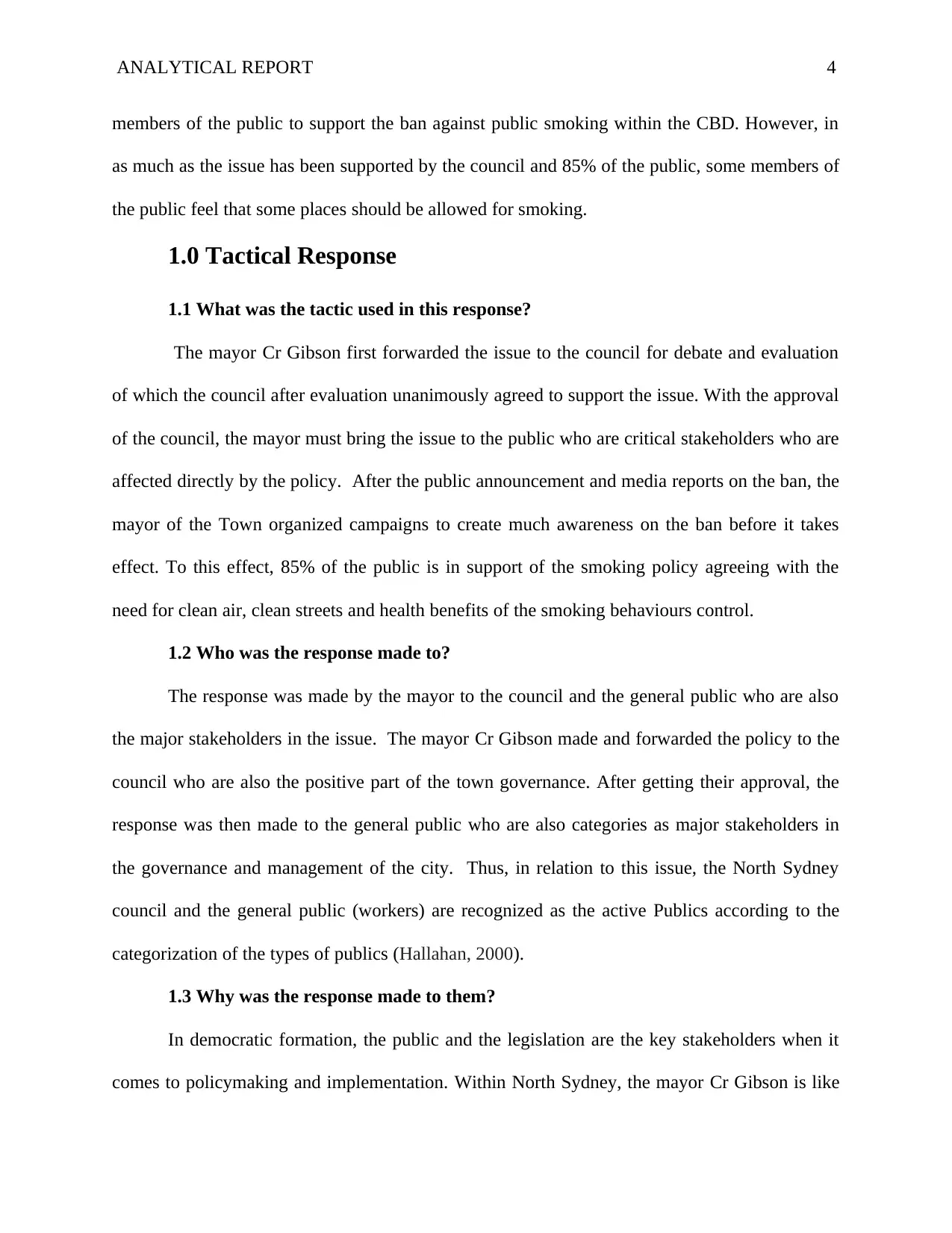
ANALYTICAL REPORT 4
members of the public to support the ban against public smoking within the CBD. However, in
as much as the issue has been supported by the council and 85% of the public, some members of
the public feel that some places should be allowed for smoking.
1.0 Tactical Response
1.1 What was the tactic used in this response?
The mayor Cr Gibson first forwarded the issue to the council for debate and evaluation
of which the council after evaluation unanimously agreed to support the issue. With the approval
of the council, the mayor must bring the issue to the public who are critical stakeholders who are
affected directly by the policy. After the public announcement and media reports on the ban, the
mayor of the Town organized campaigns to create much awareness on the ban before it takes
effect. To this effect, 85% of the public is in support of the smoking policy agreeing with the
need for clean air, clean streets and health benefits of the smoking behaviours control.
1.2 Who was the response made to?
The response was made by the mayor to the council and the general public who are also
the major stakeholders in the issue. The mayor Cr Gibson made and forwarded the policy to the
council who are also the positive part of the town governance. After getting their approval, the
response was then made to the general public who are also categories as major stakeholders in
the governance and management of the city. Thus, in relation to this issue, the North Sydney
council and the general public (workers) are recognized as the active Publics according to the
categorization of the types of publics (Hallahan, 2000).
1.3 Why was the response made to them?
In democratic formation, the public and the legislation are the key stakeholders when it
comes to policymaking and implementation. Within North Sydney, the mayor Cr Gibson is like
members of the public to support the ban against public smoking within the CBD. However, in
as much as the issue has been supported by the council and 85% of the public, some members of
the public feel that some places should be allowed for smoking.
1.0 Tactical Response
1.1 What was the tactic used in this response?
The mayor Cr Gibson first forwarded the issue to the council for debate and evaluation
of which the council after evaluation unanimously agreed to support the issue. With the approval
of the council, the mayor must bring the issue to the public who are critical stakeholders who are
affected directly by the policy. After the public announcement and media reports on the ban, the
mayor of the Town organized campaigns to create much awareness on the ban before it takes
effect. To this effect, 85% of the public is in support of the smoking policy agreeing with the
need for clean air, clean streets and health benefits of the smoking behaviours control.
1.2 Who was the response made to?
The response was made by the mayor to the council and the general public who are also
the major stakeholders in the issue. The mayor Cr Gibson made and forwarded the policy to the
council who are also the positive part of the town governance. After getting their approval, the
response was then made to the general public who are also categories as major stakeholders in
the governance and management of the city. Thus, in relation to this issue, the North Sydney
council and the general public (workers) are recognized as the active Publics according to the
categorization of the types of publics (Hallahan, 2000).
1.3 Why was the response made to them?
In democratic formation, the public and the legislation are the key stakeholders when it
comes to policymaking and implementation. Within North Sydney, the mayor Cr Gibson is like
Paraphrase This Document
Need a fresh take? Get an instant paraphrase of this document with our AI Paraphraser
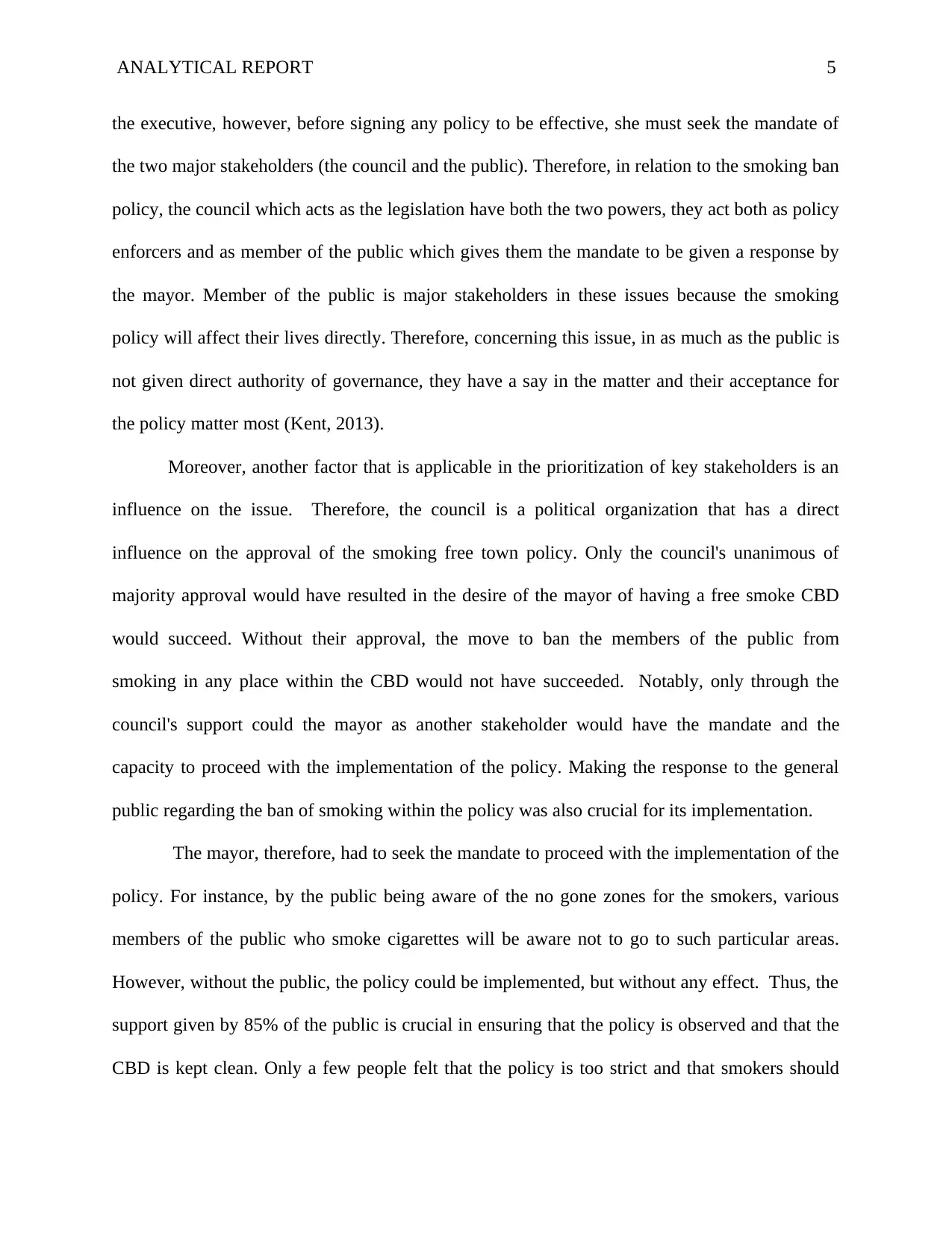
ANALYTICAL REPORT 5
the executive, however, before signing any policy to be effective, she must seek the mandate of
the two major stakeholders (the council and the public). Therefore, in relation to the smoking ban
policy, the council which acts as the legislation have both the two powers, they act both as policy
enforcers and as member of the public which gives them the mandate to be given a response by
the mayor. Member of the public is major stakeholders in these issues because the smoking
policy will affect their lives directly. Therefore, concerning this issue, in as much as the public is
not given direct authority of governance, they have a say in the matter and their acceptance for
the policy matter most (Kent, 2013).
Moreover, another factor that is applicable in the prioritization of key stakeholders is an
influence on the issue. Therefore, the council is a political organization that has a direct
influence on the approval of the smoking free town policy. Only the council's unanimous of
majority approval would have resulted in the desire of the mayor of having a free smoke CBD
would succeed. Without their approval, the move to ban the members of the public from
smoking in any place within the CBD would not have succeeded. Notably, only through the
council's support could the mayor as another stakeholder would have the mandate and the
capacity to proceed with the implementation of the policy. Making the response to the general
public regarding the ban of smoking within the policy was also crucial for its implementation.
The mayor, therefore, had to seek the mandate to proceed with the implementation of the
policy. For instance, by the public being aware of the no gone zones for the smokers, various
members of the public who smoke cigarettes will be aware not to go to such particular areas.
However, without the public, the policy could be implemented, but without any effect. Thus, the
support given by 85% of the public is crucial in ensuring that the policy is observed and that the
CBD is kept clean. Only a few people felt that the policy is too strict and that smokers should
the executive, however, before signing any policy to be effective, she must seek the mandate of
the two major stakeholders (the council and the public). Therefore, in relation to the smoking ban
policy, the council which acts as the legislation have both the two powers, they act both as policy
enforcers and as member of the public which gives them the mandate to be given a response by
the mayor. Member of the public is major stakeholders in these issues because the smoking
policy will affect their lives directly. Therefore, concerning this issue, in as much as the public is
not given direct authority of governance, they have a say in the matter and their acceptance for
the policy matter most (Kent, 2013).
Moreover, another factor that is applicable in the prioritization of key stakeholders is an
influence on the issue. Therefore, the council is a political organization that has a direct
influence on the approval of the smoking free town policy. Only the council's unanimous of
majority approval would have resulted in the desire of the mayor of having a free smoke CBD
would succeed. Without their approval, the move to ban the members of the public from
smoking in any place within the CBD would not have succeeded. Notably, only through the
council's support could the mayor as another stakeholder would have the mandate and the
capacity to proceed with the implementation of the policy. Making the response to the general
public regarding the ban of smoking within the policy was also crucial for its implementation.
The mayor, therefore, had to seek the mandate to proceed with the implementation of the
policy. For instance, by the public being aware of the no gone zones for the smokers, various
members of the public who smoke cigarettes will be aware not to go to such particular areas.
However, without the public, the policy could be implemented, but without any effect. Thus, the
support given by 85% of the public is crucial in ensuring that the policy is observed and that the
CBD is kept clean. Only a few people felt that the policy is too strict and that smokers should
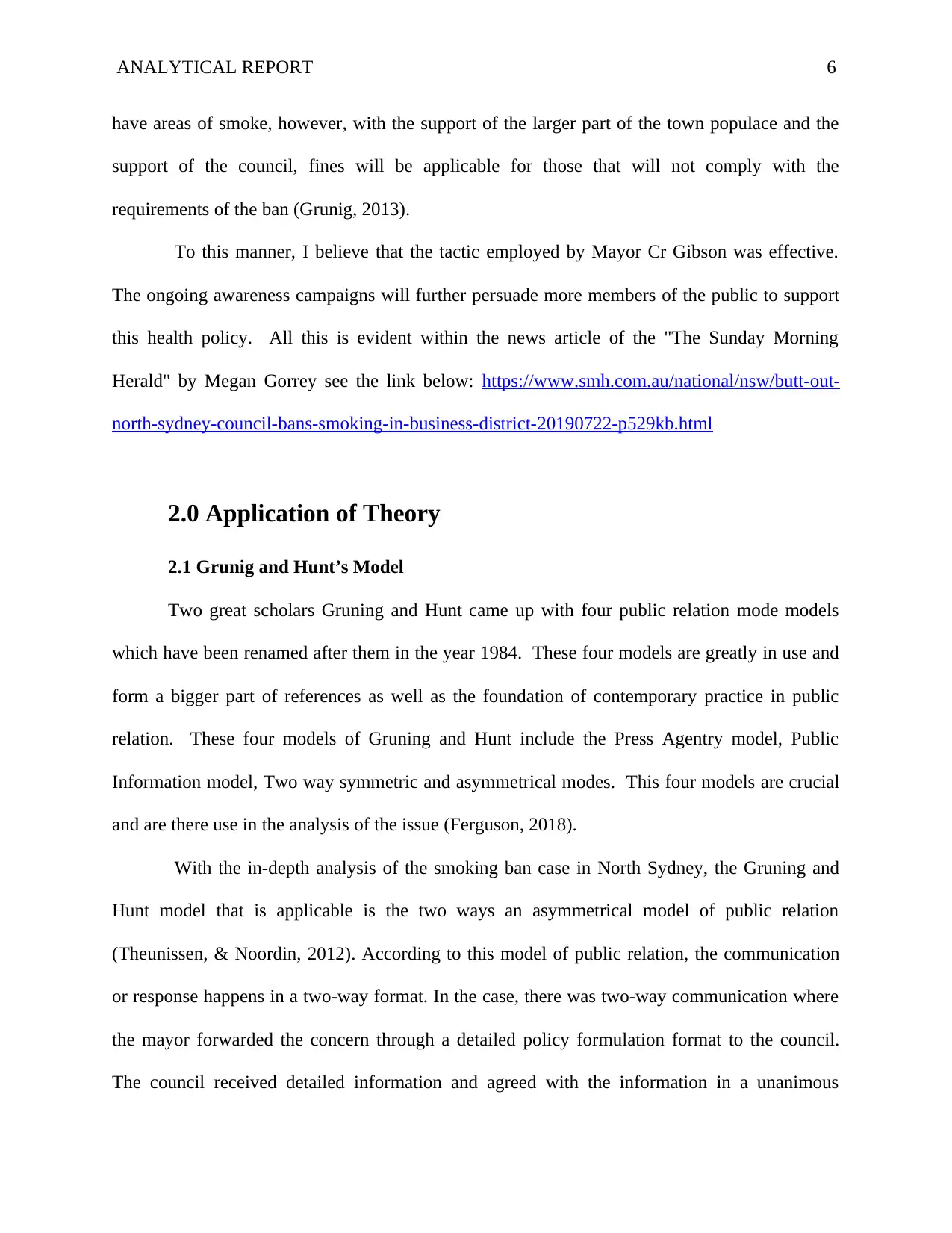
ANALYTICAL REPORT 6
have areas of smoke, however, with the support of the larger part of the town populace and the
support of the council, fines will be applicable for those that will not comply with the
requirements of the ban (Grunig, 2013).
To this manner, I believe that the tactic employed by Mayor Cr Gibson was effective.
The ongoing awareness campaigns will further persuade more members of the public to support
this health policy. All this is evident within the news article of the "The Sunday Morning
Herald" by Megan Gorrey see the link below: https://www.smh.com.au/national/nsw/butt-out-
north-sydney-council-bans-smoking-in-business-district-20190722-p529kb.html
2.0 Application of Theory
2.1 Grunig and Hunt’s Model
Two great scholars Gruning and Hunt came up with four public relation mode models
which have been renamed after them in the year 1984. These four models are greatly in use and
form a bigger part of references as well as the foundation of contemporary practice in public
relation. These four models of Gruning and Hunt include the Press Agentry model, Public
Information model, Two way symmetric and asymmetrical modes. This four models are crucial
and are there use in the analysis of the issue (Ferguson, 2018).
With the in-depth analysis of the smoking ban case in North Sydney, the Gruning and
Hunt model that is applicable is the two ways an asymmetrical model of public relation
(Theunissen, & Noordin, 2012). According to this model of public relation, the communication
or response happens in a two-way format. In the case, there was two-way communication where
the mayor forwarded the concern through a detailed policy formulation format to the council.
The council received detailed information and agreed with the information in a unanimous
have areas of smoke, however, with the support of the larger part of the town populace and the
support of the council, fines will be applicable for those that will not comply with the
requirements of the ban (Grunig, 2013).
To this manner, I believe that the tactic employed by Mayor Cr Gibson was effective.
The ongoing awareness campaigns will further persuade more members of the public to support
this health policy. All this is evident within the news article of the "The Sunday Morning
Herald" by Megan Gorrey see the link below: https://www.smh.com.au/national/nsw/butt-out-
north-sydney-council-bans-smoking-in-business-district-20190722-p529kb.html
2.0 Application of Theory
2.1 Grunig and Hunt’s Model
Two great scholars Gruning and Hunt came up with four public relation mode models
which have been renamed after them in the year 1984. These four models are greatly in use and
form a bigger part of references as well as the foundation of contemporary practice in public
relation. These four models of Gruning and Hunt include the Press Agentry model, Public
Information model, Two way symmetric and asymmetrical modes. This four models are crucial
and are there use in the analysis of the issue (Ferguson, 2018).
With the in-depth analysis of the smoking ban case in North Sydney, the Gruning and
Hunt model that is applicable is the two ways an asymmetrical model of public relation
(Theunissen, & Noordin, 2012). According to this model of public relation, the communication
or response happens in a two-way format. In the case, there was two-way communication where
the mayor forwarded the concern through a detailed policy formulation format to the council.
The council received detailed information and agreed with the information in a unanimous
⊘ This is a preview!⊘
Do you want full access?
Subscribe today to unlock all pages.

Trusted by 1+ million students worldwide
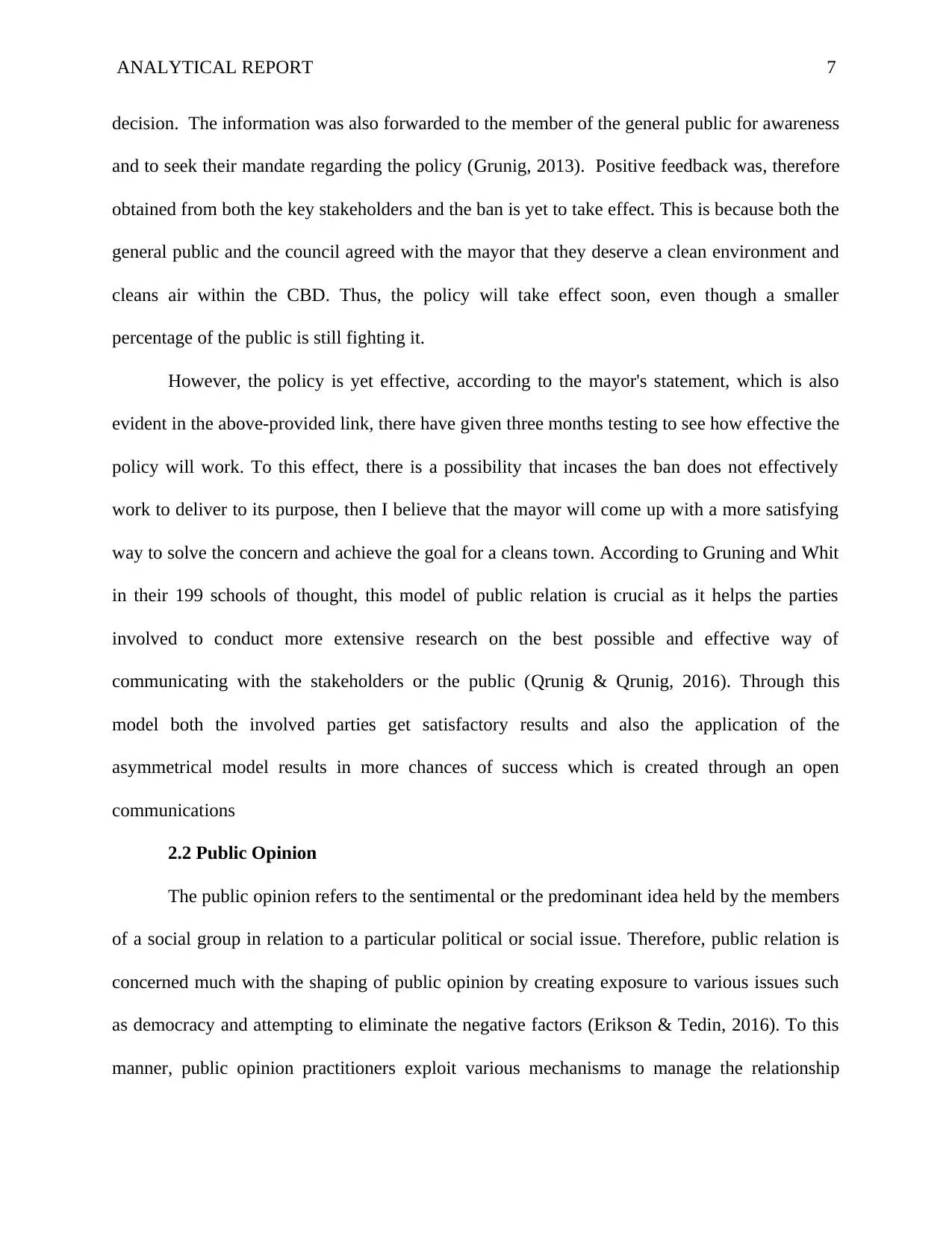
ANALYTICAL REPORT 7
decision. The information was also forwarded to the member of the general public for awareness
and to seek their mandate regarding the policy (Grunig, 2013). Positive feedback was, therefore
obtained from both the key stakeholders and the ban is yet to take effect. This is because both the
general public and the council agreed with the mayor that they deserve a clean environment and
cleans air within the CBD. Thus, the policy will take effect soon, even though a smaller
percentage of the public is still fighting it.
However, the policy is yet effective, according to the mayor's statement, which is also
evident in the above-provided link, there have given three months testing to see how effective the
policy will work. To this effect, there is a possibility that incases the ban does not effectively
work to deliver to its purpose, then I believe that the mayor will come up with a more satisfying
way to solve the concern and achieve the goal for a cleans town. According to Gruning and Whit
in their 199 schools of thought, this model of public relation is crucial as it helps the parties
involved to conduct more extensive research on the best possible and effective way of
communicating with the stakeholders or the public (Qrunig & Qrunig, 2016). Through this
model both the involved parties get satisfactory results and also the application of the
asymmetrical model results in more chances of success which is created through an open
communications
2.2 Public Opinion
The public opinion refers to the sentimental or the predominant idea held by the members
of a social group in relation to a particular political or social issue. Therefore, public relation is
concerned much with the shaping of public opinion by creating exposure to various issues such
as democracy and attempting to eliminate the negative factors (Erikson & Tedin, 2016). To this
manner, public opinion practitioners exploit various mechanisms to manage the relationship
decision. The information was also forwarded to the member of the general public for awareness
and to seek their mandate regarding the policy (Grunig, 2013). Positive feedback was, therefore
obtained from both the key stakeholders and the ban is yet to take effect. This is because both the
general public and the council agreed with the mayor that they deserve a clean environment and
cleans air within the CBD. Thus, the policy will take effect soon, even though a smaller
percentage of the public is still fighting it.
However, the policy is yet effective, according to the mayor's statement, which is also
evident in the above-provided link, there have given three months testing to see how effective the
policy will work. To this effect, there is a possibility that incases the ban does not effectively
work to deliver to its purpose, then I believe that the mayor will come up with a more satisfying
way to solve the concern and achieve the goal for a cleans town. According to Gruning and Whit
in their 199 schools of thought, this model of public relation is crucial as it helps the parties
involved to conduct more extensive research on the best possible and effective way of
communicating with the stakeholders or the public (Qrunig & Qrunig, 2016). Through this
model both the involved parties get satisfactory results and also the application of the
asymmetrical model results in more chances of success which is created through an open
communications
2.2 Public Opinion
The public opinion refers to the sentimental or the predominant idea held by the members
of a social group in relation to a particular political or social issue. Therefore, public relation is
concerned much with the shaping of public opinion by creating exposure to various issues such
as democracy and attempting to eliminate the negative factors (Erikson & Tedin, 2016). To this
manner, public opinion practitioners exploit various mechanisms to manage the relationship
Paraphrase This Document
Need a fresh take? Get an instant paraphrase of this document with our AI Paraphraser
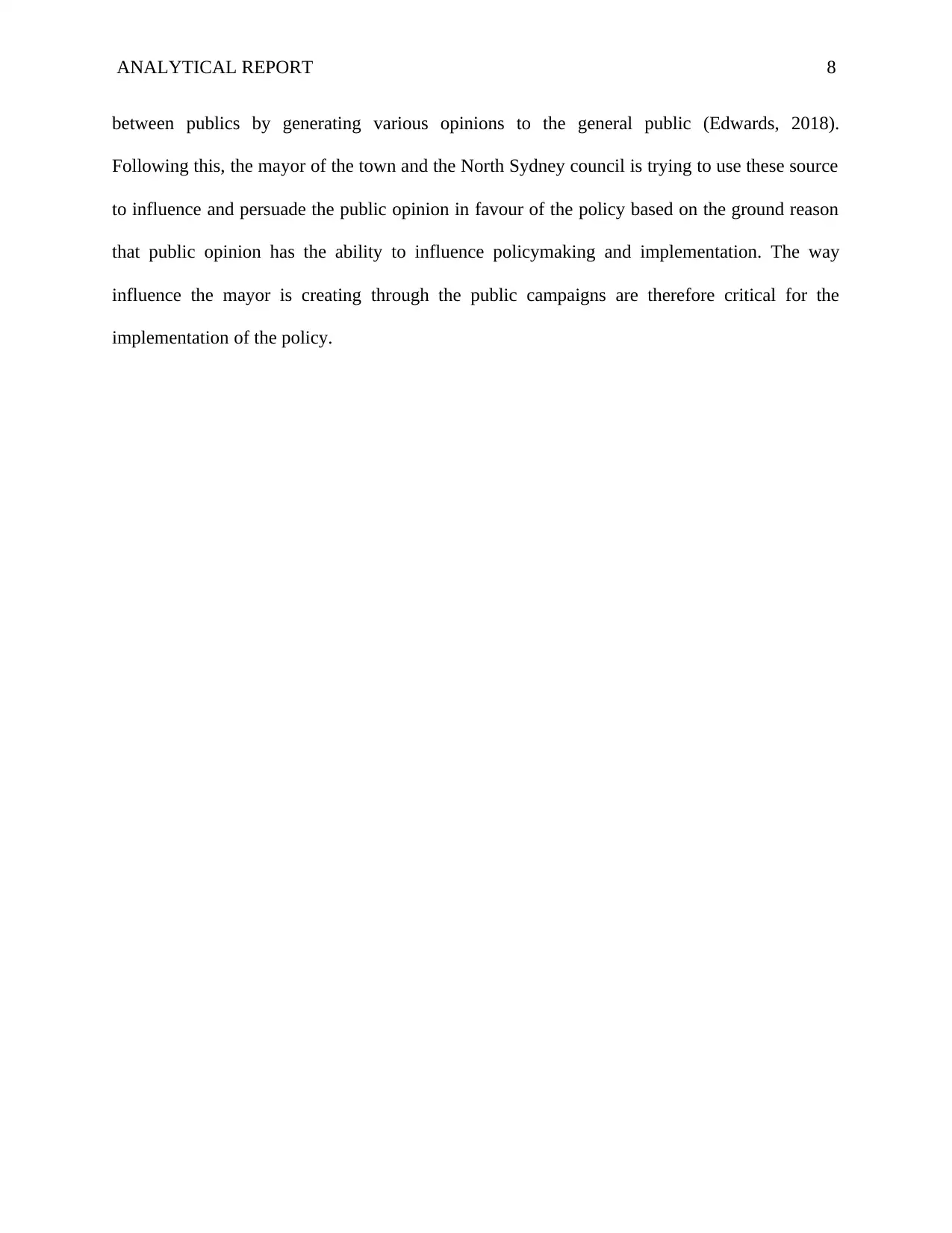
ANALYTICAL REPORT 8
between publics by generating various opinions to the general public (Edwards, 2018).
Following this, the mayor of the town and the North Sydney council is trying to use these source
to influence and persuade the public opinion in favour of the policy based on the ground reason
that public opinion has the ability to influence policymaking and implementation. The way
influence the mayor is creating through the public campaigns are therefore critical for the
implementation of the policy.
between publics by generating various opinions to the general public (Edwards, 2018).
Following this, the mayor of the town and the North Sydney council is trying to use these source
to influence and persuade the public opinion in favour of the policy based on the ground reason
that public opinion has the ability to influence policymaking and implementation. The way
influence the mayor is creating through the public campaigns are therefore critical for the
implementation of the policy.
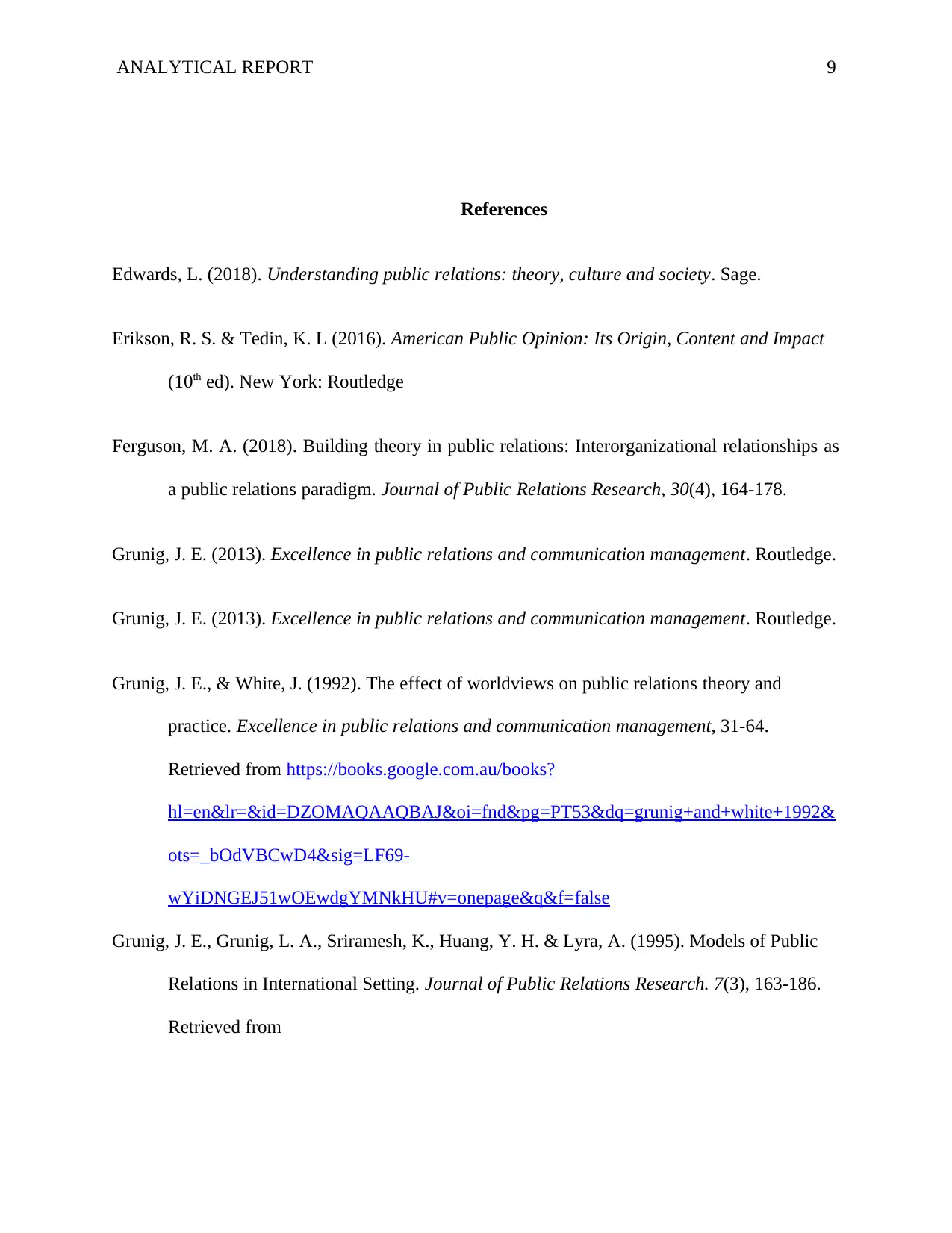
ANALYTICAL REPORT 9
References
Edwards, L. (2018). Understanding public relations: theory, culture and society. Sage.
Erikson, R. S. & Tedin, K. L (2016). American Public Opinion: Its Origin, Content and Impact
(10th ed). New York: Routledge
Ferguson, M. A. (2018). Building theory in public relations: Interorganizational relationships as
a public relations paradigm. Journal of Public Relations Research, 30(4), 164-178.
Grunig, J. E. (2013). Excellence in public relations and communication management. Routledge.
Grunig, J. E. (2013). Excellence in public relations and communication management. Routledge.
Grunig, J. E., & White, J. (1992). The effect of worldviews on public relations theory and
practice. Excellence in public relations and communication management, 31-64.
Retrieved from https://books.google.com.au/books?
hl=en&lr=&id=DZOMAQAAQBAJ&oi=fnd&pg=PT53&dq=grunig+and+white+1992&
ots=_bOdVBCwD4&sig=LF69-
wYiDNGEJ51wOEwdgYMNkHU#v=onepage&q&f=false
Grunig, J. E., Grunig, L. A., Sriramesh, K., Huang, Y. H. & Lyra, A. (1995). Models of Public
Relations in International Setting. Journal of Public Relations Research. 7(3), 163-186.
Retrieved from
References
Edwards, L. (2018). Understanding public relations: theory, culture and society. Sage.
Erikson, R. S. & Tedin, K. L (2016). American Public Opinion: Its Origin, Content and Impact
(10th ed). New York: Routledge
Ferguson, M. A. (2018). Building theory in public relations: Interorganizational relationships as
a public relations paradigm. Journal of Public Relations Research, 30(4), 164-178.
Grunig, J. E. (2013). Excellence in public relations and communication management. Routledge.
Grunig, J. E. (2013). Excellence in public relations and communication management. Routledge.
Grunig, J. E., & White, J. (1992). The effect of worldviews on public relations theory and
practice. Excellence in public relations and communication management, 31-64.
Retrieved from https://books.google.com.au/books?
hl=en&lr=&id=DZOMAQAAQBAJ&oi=fnd&pg=PT53&dq=grunig+and+white+1992&
ots=_bOdVBCwD4&sig=LF69-
wYiDNGEJ51wOEwdgYMNkHU#v=onepage&q&f=false
Grunig, J. E., Grunig, L. A., Sriramesh, K., Huang, Y. H. & Lyra, A. (1995). Models of Public
Relations in International Setting. Journal of Public Relations Research. 7(3), 163-186.
Retrieved from
⊘ This is a preview!⊘
Do you want full access?
Subscribe today to unlock all pages.

Trusted by 1+ million students worldwide
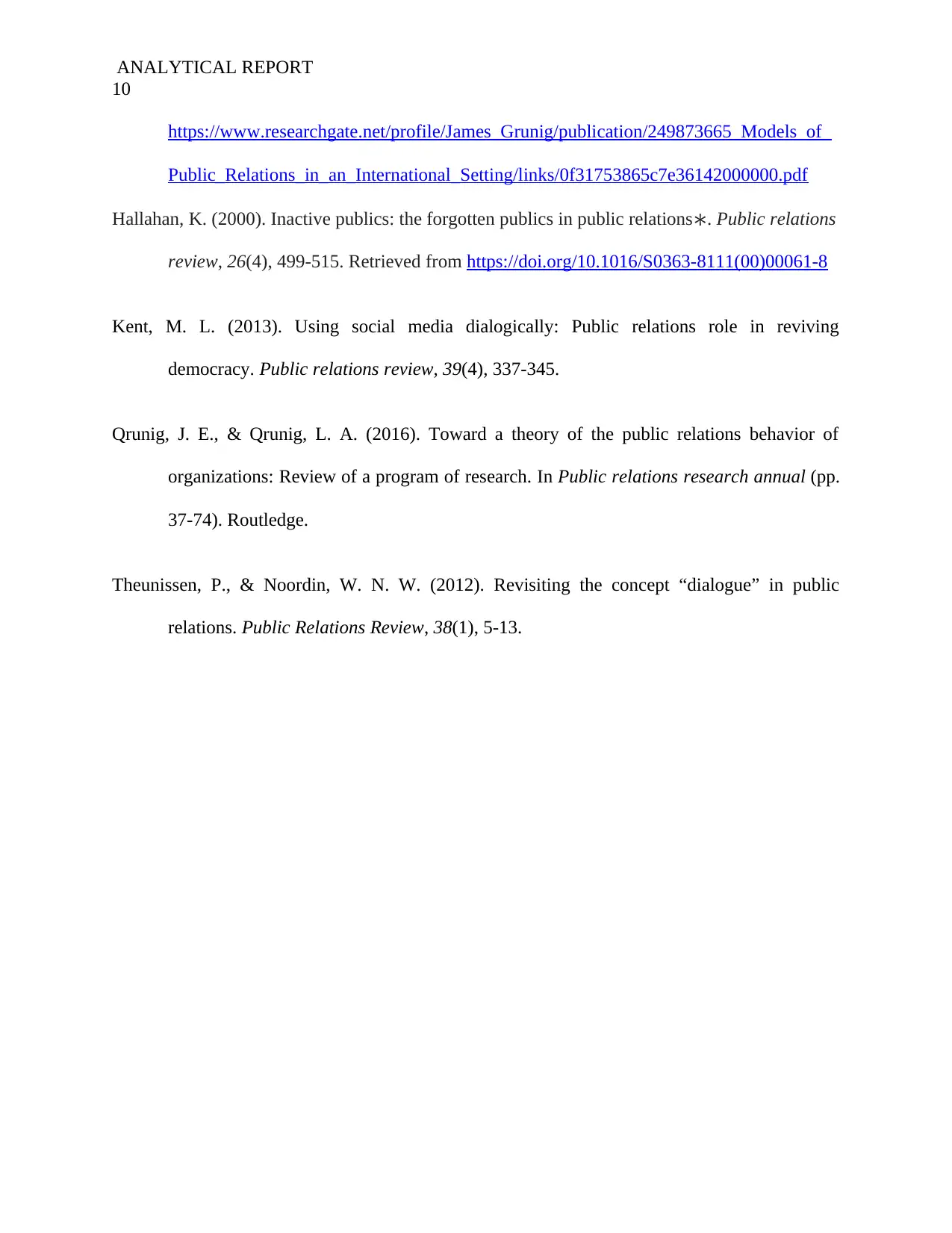
ANALYTICAL REPORT
10
https://www.researchgate.net/profile/James_Grunig/publication/249873665_Models_of_
Public_Relations_in_an_International_Setting/links/0f31753865c7e36142000000.pdf
Hallahan, K. (2000). Inactive publics: the forgotten publics in public relations∗. Public relations
review, 26(4), 499-515. Retrieved from https://doi.org/10.1016/S0363-8111(00)00061-8
Kent, M. L. (2013). Using social media dialogically: Public relations role in reviving
democracy. Public relations review, 39(4), 337-345.
Qrunig, J. E., & Qrunig, L. A. (2016). Toward a theory of the public relations behavior of
organizations: Review of a program of research. In Public relations research annual (pp.
37-74). Routledge.
Theunissen, P., & Noordin, W. N. W. (2012). Revisiting the concept “dialogue” in public
relations. Public Relations Review, 38(1), 5-13.
10
https://www.researchgate.net/profile/James_Grunig/publication/249873665_Models_of_
Public_Relations_in_an_International_Setting/links/0f31753865c7e36142000000.pdf
Hallahan, K. (2000). Inactive publics: the forgotten publics in public relations∗. Public relations
review, 26(4), 499-515. Retrieved from https://doi.org/10.1016/S0363-8111(00)00061-8
Kent, M. L. (2013). Using social media dialogically: Public relations role in reviving
democracy. Public relations review, 39(4), 337-345.
Qrunig, J. E., & Qrunig, L. A. (2016). Toward a theory of the public relations behavior of
organizations: Review of a program of research. In Public relations research annual (pp.
37-74). Routledge.
Theunissen, P., & Noordin, W. N. W. (2012). Revisiting the concept “dialogue” in public
relations. Public Relations Review, 38(1), 5-13.
1 out of 10
Your All-in-One AI-Powered Toolkit for Academic Success.
+13062052269
info@desklib.com
Available 24*7 on WhatsApp / Email
![[object Object]](/_next/static/media/star-bottom.7253800d.svg)
Unlock your academic potential
Copyright © 2020–2025 A2Z Services. All Rights Reserved. Developed and managed by ZUCOL.
